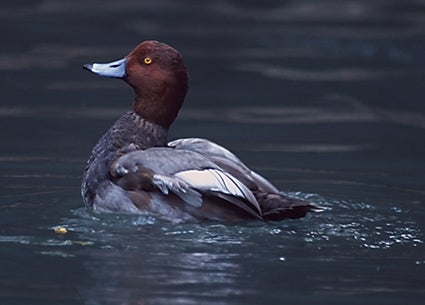SCIENTIFIC NAME:
Aythya americana
STATUS:
Uncommon in winter, spring, and fall, and occasional in summer in all regions. Low Conservation Concern.
DESCRIPTION:
A medium-size diving duck with a length of 18 to 22 inches and weight of 1.5 to 3.2 lbs. Males have a reddish head and upper neck with a black lower neck, fore back and breast. The rest of their back is a dark grayish color. A broad band of light gray extends across their wing and onto the primaries. The legs and feet are gray and the forehead is abrupt, not sloped like the canvasbacks. The bill is short, broad and blue with a dark tip. Females have a duller, reddish brown head, neck and breast with a buff white chin and throat. The eye has a white ring with a white stripe behind the eye. The female’s body is brown and the wing-coverts are browner than the male’s. The bill is a dull blue compared to the males and the tip is dark.
DISTRIBUTION:
During the breeding season, redheads are commonly found across the prairie pothole region of British Columbia with small breeding populations located in the southern end of New Brunswick and Nova Scotia. Other breeding populations are located in the northwest and central northwest United States. As the winter migration season begins, redheads will move south, following one of the four major flyways, to wintering grounds in Texas, Mexico and along the gulf coast from Texas to Florida.
HABITAT:
During the breeding season, redheads prefer non-forested areas with large slough and marshes that are surrounded by tall vegetation with cattails, bulrush and reeds. During the winter months, they can be found on freshwater lakes, ponds, marshes, coastal waters and bays.
FEEDING HABITS:
Redheads feed by diving under water to feed on seeds, rhizomes, and tubers of pondweeds, wild celery, water lilies and grasses. They will also eat aquatic insects, mollusks and small fishes.
LIFE HISTORY AND ECOLOGY:
They will begin to pair in late winter with several males competing for a female. The males will conduct gymnastic like behavior in order to attract a female for a breeding partner. Once the pair bonds have been established, females begin nesting in late April. The female will construct a nest of floating vegetation over deep water that is made up of reeds and cattail blades. She will not add down to her nest until the completion of laying her eggs. The female will lay a clutch of 10 to 15 eggs and incubate for about 25 days before hatching. If available breeding habitat is low, female redheads will lay their eggs in nests of other ducks. Due to a late hatching season, young redheads are barely able to fly by winter freezing and are sexually immature for the following breeding season.
Like most waterfowl,, redhead populations fluctuate year by year depending on available nesting and brooding habitat in the northern breeding areas of Canada and the US. In Alabama, small numbers of redheads will migrate through on their way to wintering ground along the gulf coast.
REFERENCES:
Bellrose, F.C. 1976. Ducks, geese and Swans of North America, 2nd ed. Stackpole PA.
Ducks Unlimited-www.ducks.org
Delta Waterfowl-www.deltawaterfowl.org
Author:
Phil Miller, Wildlife Biologist, Division of Wildlife and Freshwater Fisheries






